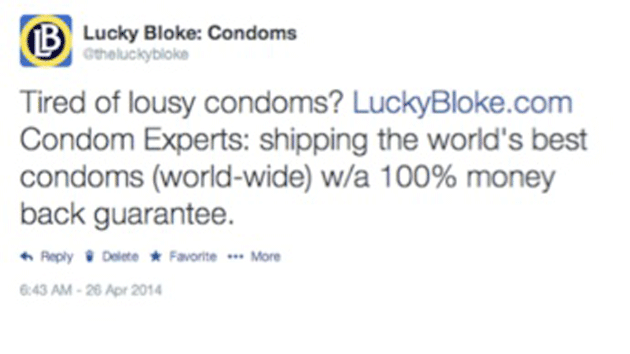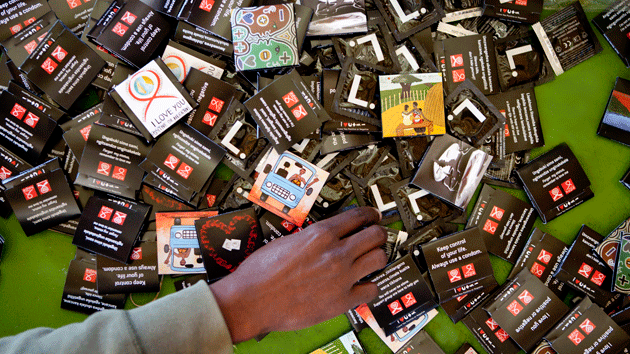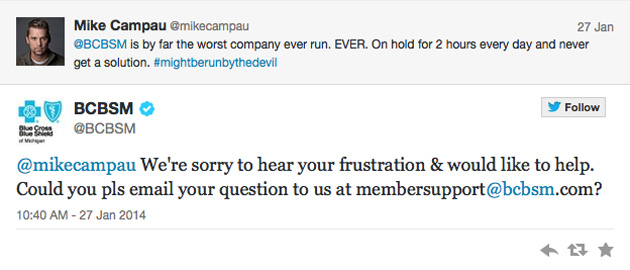
<a href="http://flickr.com/link-to-source-image">VancityAllie</a>/Flickr
Most businesses that accept advertising—from magazines and television networks to news websites and Facebook—accept ads for condoms. But earlier this year, Melissa White, the CEO of Lucky Bloke Condoms, learned that there’s one major exception: Twitter.
For months, Twitter had spammed White with emails encouraging her to try sending a promoted Tweet—a paid advertisement that shows up in other users’ tweet streams. But when she finally sent one—a relatively anodyne message asking readers if they were “tired of lousy condoms”—it was quickly rejected. “Your account is ineligible to participate in the Twitter ads program at this time based on the Twitter Ads adult sexual products and services policy,” Twitter wrote to her. Baffled, White wrote a piece for RH Reality Check complaining about how her company was treated.
A Twitter spokesman says the company “allows and encourages ads from condom companies and safer sex education organizations,” noting that condom giant Durex and a number of HIV and STD awareness campaigns have advertised on the social network. But several condom companies and safe-sex advocates say that the Durex campaign was the exception, not the rule—and that in practice, Twitter bans most condom advertising and safe-sex advocacy from its promoted tweets program.


Twitter’s advertising policy, which says the company bans “the promotion of adult or sexual products and services,” including “contraceptives,” only confuses the issue. The multi-page policy goes on to clarify that Twitter allows condom ads, but only if they are targeted at Australia, Brazil, Canada, France, Germany, Ireland, Italy, the Netherlands, New Zealand, Spain, the United Kingdom, or the US—and then only if they “comply with all local laws,” and “do not contain or link to any sexual content.” (That can be a challenge, given that condoms are used for sex.) White says she “was aware” of the geographical restrictions in Twitter’s condom ad policies and “was very careful to select only countries approved in that section.” She only targeted users who were over 18 and followers of “sex and relationship personalities,” such as Dan Savage and Emily Morse. But she was blocked from the program anyway—and Twitter won’t explain why, either to White or to Mother Jones.
White isn’t the only person complaining that Twitter’s rules about sexual content in ads are too strict. Last October, Jenelle Marie, founder of The STD Project, a site that offers resources for people suffering from sexually transmitted diseases, tried to use the promoted tweets program to send out a link to her site. Her first promoted tweet, which Marie recalls saying “STD? It’s Ok! We can help,” was deleted. Marie says she was “surprised” and “disconcerted” that Twitter wasn’t allowing her to promote safe sex. Third party ads on her site—which occasionally include condom ads—might have been to blame, she says. Twitter rejects sexual content if it’s in either the tweet itself or on the landing page of the link.
Several other small companies have similar complaints. Momdoms, a company that sells vintage tins with sex jokes for a “less awkward birds and bees talk,” was booted from the promoted tweets program after tweeting out a YouTube video advertising its products. Bedsider, a “birth control support network” that provides information and support on birth control topics and options, still tweets, but has twice been temporarily banned.
White’s negative experience is preventing other companies from trying the ad program in the first place. Jason Panda, the head of b condoms, a condom manufacturer that aims to promote healthy lifestyles among minority populations, says he “heard about what’s happened with Lucky Bloke” and decided investing in promoted tweets wasn’t worth the hassle. “We were interested in shifting our advertising to begin promoting tweets and advertising on Twitter because it’s a powerful way to connect with the underserved communities that we target,” Panda wrote in an email. “However, it’s hard to promote safe sex when awesome tools like Twitter block companies like ours from reaching the communities that need the information the most.”
Condoms, which the US Food and Drug Administration classifies as medical devices, may be considered scandalous on Twitter, but they’re widely available in stores. There is no federal age restriction on the purchase of condoms in the United States; anyone, even a child, can legally walk into a pharmacy and purchase a condom.
White sees this moment as an opportunity for Twitter. “Twitter’s current policies are out-dated, irresponsible and even dangerous,” she says. “For Twitter, this presents a chance to demonstrate an enlightened, mature, up-to-date understanding of user safety and extend their global reach to their users on matters of sexual health—[by providing] info with true life-saving potential.”











